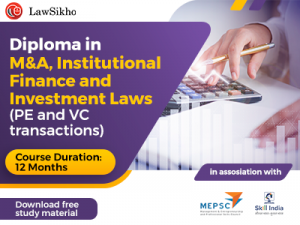
This article has been written by Kopal Agarwal, pursuing a Diploma in M&A, Institutional Finance, and Investment Laws (PE and VC transactions) from LawSikho.
Table of Contents
Introduction
While the economy continues to grow on a global scale, large companies seeking to stay competitive must look to international markets as a means of expansion and trade. As international mergers become a more common means of accomplishing these goals, an increasing number of countries are adopting competition laws to prevent any possible anti-competitive activities by merging companies.
Recently in 2020, the anti-trust federation of USA alleged that Facebook has been involved in monopolizing the social networking domain for quite some time with the strategic acquisition of its rivals Whatsapp and Instagram and imposing conditions of an anti-competitive nature on its software developers to discourage any kind of competition leaving less choice for consumers in social networking.
Back in 2017, the proposed merger of AT&T communications, one of the world’s largest wireless and telecommunications companies, and Time Warner, one of the world’s largest media and entertainment companies was objected by the antitrust authority of US who claimed the merger would put “too much concentration of power in the hands of too few”.
Due to an exponential increase in mergers in the past few decades, the merger control regimes are diligently scrutinizing every deal to maintain healthy and balanced competition across all sectors of the economy. One such example is the USA, where antitrust laws are extensive and most aggressively enforced in the world. This article will discuss the merger control authority of the US and the corresponding laws and some examples of recent mergers in the US as well.
The regulatory framework
Before discussing the regulatory framework, let us first understand the meaning of “merger control”. It is simply a procedure to appraise mergers and acquisitions under competition laws. It is adopted to check whether the resultant concentration i.e M&A does not become dominant, hindering the competition in the market.
In the US, the merger control authority/agency is the Federal Trade Commission (FTC) and the antitrust division of the Department Of Justice (DOJ). They can enforce Section 7 of the Clayton Act (15 United States Code (USC), Section 18a) also known as the Hart Scott Rodino Antitrust Improvements Act of 1976 ( HSR act ) which is the primary legislation governing mergers in the US. This section prohibits transactions where “the effect of such acquisition may be substantially to lessen competition, or to tend to create a monopoly”. Thus any merger can be challenged that is found violating the section by creating dominance and using any kind of tactic in furtherance of that objective. The HSR Act requires certain dealings to be reported to the authorities under its premerger notification program. This program gives the authorities information about big mergers before they occur.
The enforcers
As mentioned above, the prime authorities for enforcing the HSR act are the FTC and the Department of Justice (DoJ). Either agency can block and question the deals that they feel would adversely impact the competition. Currently, the law is that if the value of the deal is more than $94 million then the company would have to intimate the agencies for review.
Procedure
- The parties (both) have to submit a formal notice to the FTC or antitrust division after which they have to wait for a specific time period which is 30 days, however, this period has been shortened to 15 days in case of bank and cash tender offer transactions.
- While the waiting period is open, the agency has the following options :
- Either open a formal investigation or an informal investigation
- Terminate the investigation if requested by the parties and if the agency has no desire in continuing the investigation
- Take no action and let the waiting period lapse
3. During the initial waiting period, the parties submit a position paper that gives the details of the transactions, answers the agency’s questions, and explains why their deal won’t affect any competition in the market.
4. The agencies if they want to can contact the other competitors in the market, customers, etc. to obtain a more clear picture of the industry.
5. However, if the question of antitrust activities still persists in the minds of the agency even after the initial waiting period then they can formally request some additional information, documents, etc. which may also be called a ‘second request’. This is generally a very detailed procedure that consists of reviewing various issues in length like the entry conditions, market structure, reason of the proposed acquisition, etc.
6. After the second request, it is up to the agency to decide whether to seek an injunction against the merger from the court or let it proceed. Another way is for the parties and the concerned agency to settle through a ‘consent agreement’ which would address the anti-competitive issue that might happen once the transaction is given a green light.
In 2018, the FTC successfully obtained an injunction in a federal court against the two largest suppliers of water treatment chemicals and services used by large ships to maintain their onboard ship equipment- Wilhelmsen Maritime and Drew Marine (see here). The FTC argued that collectively they would own about 60% of the global marine water treatment chemical and service market which resulted in the blocking of the merger and subsequently the two companies abandoned the deal.
HSR filings
We have discussed that the parties have to submit the HSR filings first. But what exactly is required in an HSR filing?
The HSR filing is a premerger notification that is required to be filed by both parties separately. This gives a brief idea to the agencies about the merger deal. Unlike the merger control system in the EU during the filing process which needs extensive information, the parties in the US just need to submit minimal information like their revenues, shareholders, and shareholdings, along with certain transaction-related documents that address competition, markets, entry, and other antitrust-relevant points.
Threshold/ triggering events
- If the size of the transaction is below $94 million then there is no need for the parties to report the merger with the agencies. If the acquisition of assets or voting securities or interests in an unincorporated entity exceeds the above limit then it is required to be reported. This limit would include the voting securities which the acquirer acquires in addition to what he already has. For eg. if A has $50 million worth of voting securities in B and if he acquires an additional $45 million worth voting securities then the limit would be said to have exceeded and the parties would then have to report the transaction. This is called the size of the transaction test.
- There is another test for determining the threshold for reporting, it is called the size of the personality test. In this test, the size of both acquired and acquiring parties is looked at. By size, we mean sales and assets of the parties. It is satisfied if one party (including all entities in its corporate family) has worldwide sales or assets of US$18 million or more (as adjusted annually), and the other has worldwide sales or assets of US$180 million or more (as adjusted annually). Sales and assets, as a general rule, are defined as those set forth in a party’s last regularly prepared income statement and balance sheet. In totality, the size of the event should range between $94 million to $376 million beyond which this test would not apply.
It is important to note that the figures of the thresholds mentioned above are changed annually by FTC.
Exemptions
The exemptions are applied to either the whole transaction or a part of the transaction depending on where the exemptions are applicable. There are two possible results after granting exemptions:
- No requirement for filing notification
- Reduction in HSR filing fee
Following are the exemptions granted by HSR Act:
- Certain acquisitions in the ordinary course of business like goods and supplies.
- Investment of up to 10% or less where the investor does not have any intention to participate in the basic decisions of the investee.
- Investment of 15% or less in investee where the investor falls in the category of a certain type of institutional investor.
- A foreign investee who does not have a substantial amount of assets or sales in the US.
- Acquisition of certain types of real estate/properties like any unproductive real properties, residential buildings, etc.
- Stock dividends and splits.
Notification requirements
Mandatory filing is required in those cases that meet the thresholds and are not under any exemptions. There is no particular set time as to when parties should file a premerger notification. However, parties may file the notification once the letter of intent is executed. The notification has to be filed to both FTC and DoJ
Filing fees
The filing fee has to be submitted prior to the date of filing otherwise the filing will be deemed to be incomplete.
- For transactions above $94 million but less than $188 million, the fees would be $45000.
- For transactions at and above $188 million but less than $940.1 million, the fee is $125,000.
- For transactions at and above $940 million, the fees would be $280,000.
Penalties and remedies
If the parties fail to notify the agencies of a reportable transaction and violate the HSR Act then the penalty is $43,792 per day. The violation would also include any omission of important documents during the filing or any gun-jumping activities like a premature implementation of the merger transaction before it is permitted by HSR Act. Incomplete and inaccurate information in the HSR filing would also attract civil penalties.
Most structural remedies like divestiture of the standalone business are the preferred route by the agency to reduce the anti-competitive effect of the proposed merger.
In 2019, Nexstar Media Group Inc. one of the leading television broadcasting companies in America proposed to acquire Tribune media again one of the leading television broadcasting companies in America. However, DoJ first required them to divest television stations in about 13 markets before permitting the deal. Their argument was that if the deal went through then it would be detrimental to the other cable and satellite TV subscribers and small businesses engaged in the broadcasting field. The divestiture was agreed and this deal proved to be the largest broadcasting merger in US history
Examples of recent mergers in the US
- T-Mobile and Sprint corporation
The DoJ approved the merger of the telecommunication companies after the divestiture of certain businesses and assets as the proposed merger received severe backlash from the agencies and state attorney generals. The merger was done with an aim to increase their market presence in providing a rapid 5G network across the country.
- Evonik and PeroxyChem
The acquisition of PeroxyChem by Evonik was successful as the Federal court refused to grant a preliminary injunction filed by FTC against the companies engaging in the production of hydrogen peroxide.
- Bristol-Myers Squibb and Celgene
The merger between the pharmaceutical companies was successful after FTC made them divest Celgene’s Otezla (oral treatment for moderate to severe psoriasis in the US) as it was directly in competition with a drug that BMS was developing.
- Morgan Stanley and E-trade
Morgan Stanley needs no introduction as the name itself is enough to understand its presence around the world. The leading financial services firm was successfully able to close its acquisition with Etrade, a successful brokerage and banking services firm in 2020 for a record $13 billion. The combination will result in further expansion of Morgan Stanley’s wealth management business.
References
LawSikho has created a telegram group for exchanging legal knowledge, referrals, and various opportunities. You can click on this link and join:
 Serato DJ Crack 2025Serato DJ PRO Crack
Serato DJ Crack 2025Serato DJ PRO Crack









 Allow notifications
Allow notifications



